Improving HRM Practices in Hospitals
VerifiedAdded on 2020/03/01
|9
|2179
|297
Case Study
AI Summary
This case study examines the human resource management challenges faced by a hospital lacking a dedicated HR department. It explores effective strategies for improving HR practices, including establishing a separate HR team, enhancing communication, and implementing fair performance appraisals. The study emphasizes the importance of supportive managerial practices and innovative approaches to build sustainable HR capabilities, ultimately aiming to reduce employee turnover and improve organizational performance.
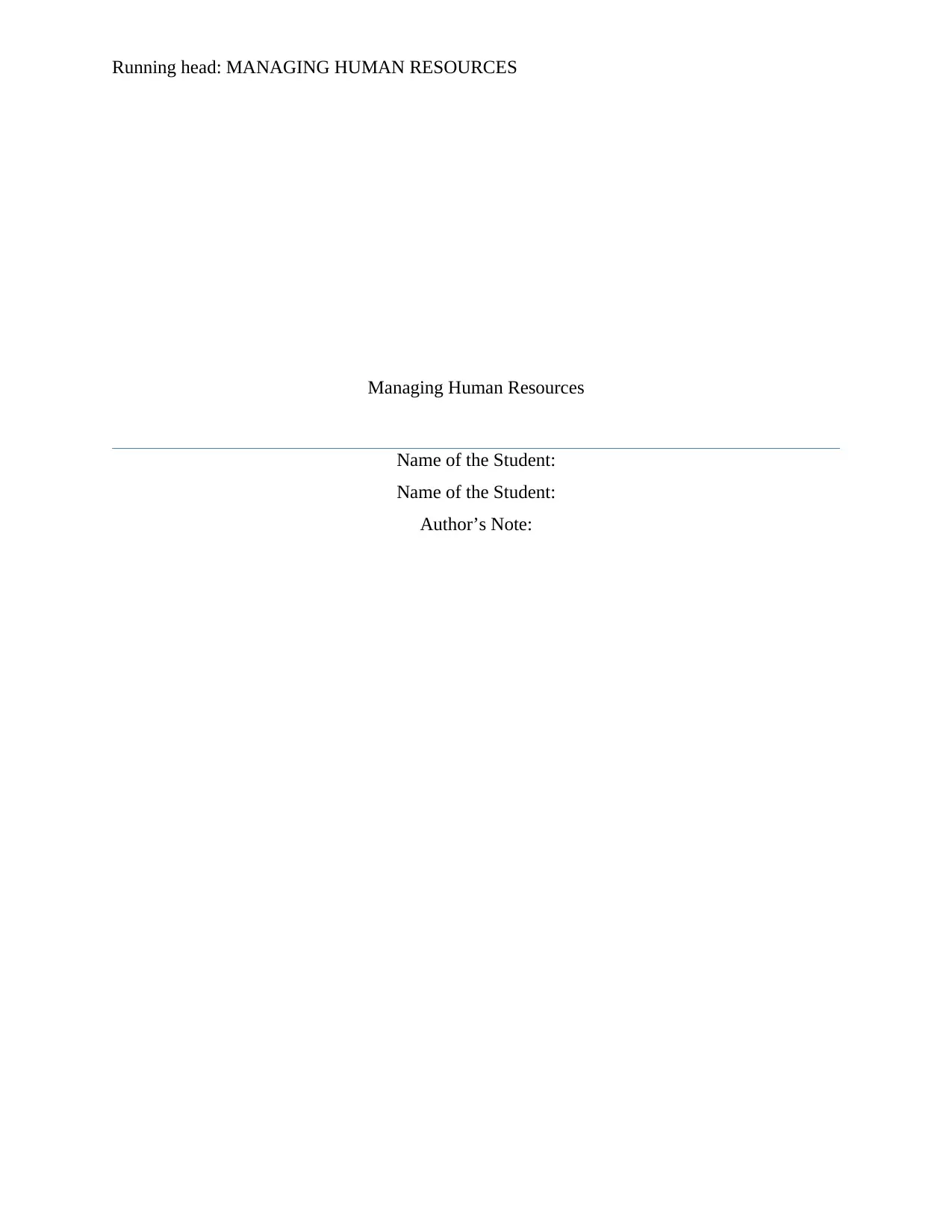
Running head: MANAGING HUMAN RESOURCES
Managing Human Resources
Name of the Student:
Name of the Student:
Author’s Note:
Managing Human Resources
Name of the Student:
Name of the Student:
Author’s Note:
Paraphrase This Document
Need a fresh take? Get an instant paraphrase of this document with our AI Paraphraser
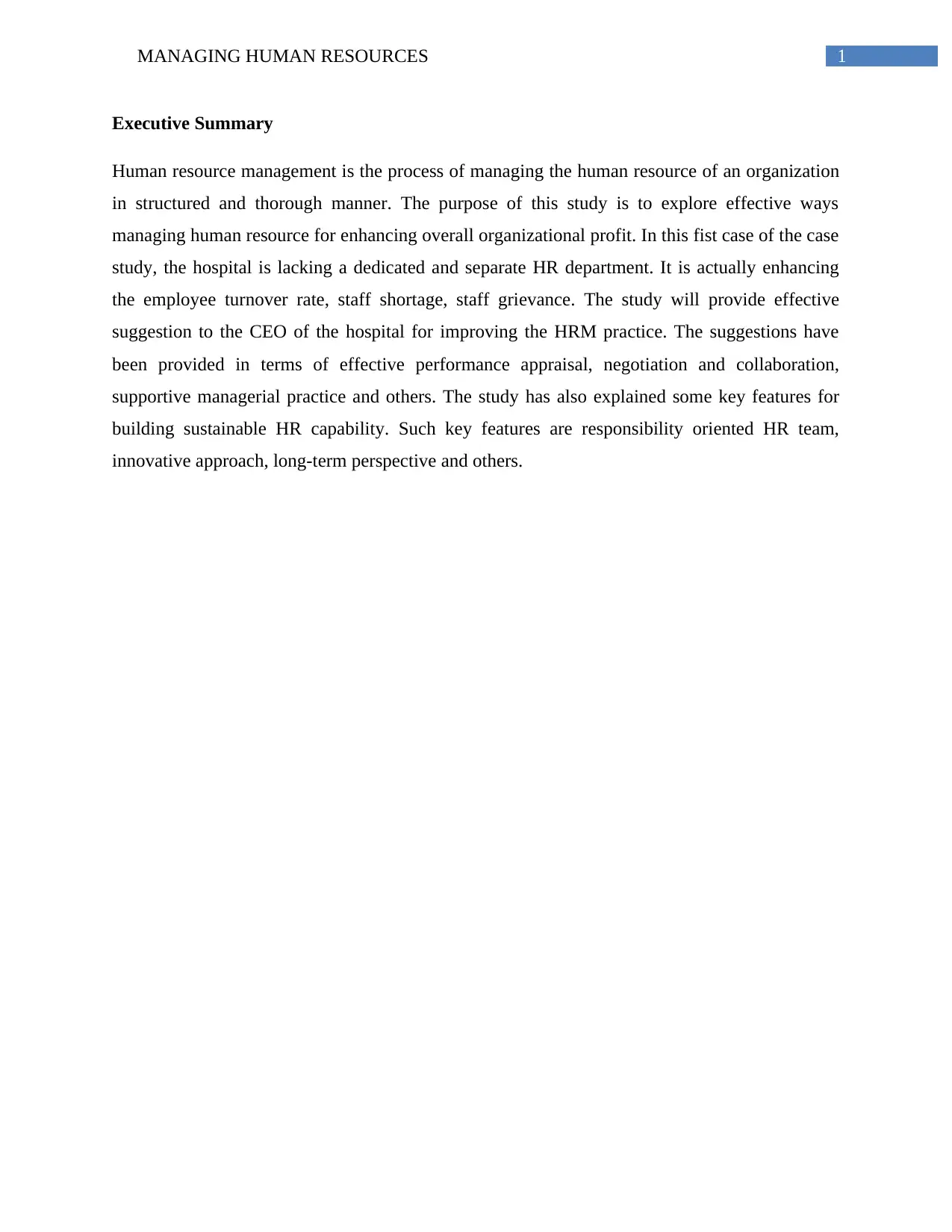
1MANAGING HUMAN RESOURCES
Executive Summary
Human resource management is the process of managing the human resource of an organization
in structured and thorough manner. The purpose of this study is to explore effective ways
managing human resource for enhancing overall organizational profit. In this fist case of the case
study, the hospital is lacking a dedicated and separate HR department. It is actually enhancing
the employee turnover rate, staff shortage, staff grievance. The study will provide effective
suggestion to the CEO of the hospital for improving the HRM practice. The suggestions have
been provided in terms of effective performance appraisal, negotiation and collaboration,
supportive managerial practice and others. The study has also explained some key features for
building sustainable HR capability. Such key features are responsibility oriented HR team,
innovative approach, long-term perspective and others.
Executive Summary
Human resource management is the process of managing the human resource of an organization
in structured and thorough manner. The purpose of this study is to explore effective ways
managing human resource for enhancing overall organizational profit. In this fist case of the case
study, the hospital is lacking a dedicated and separate HR department. It is actually enhancing
the employee turnover rate, staff shortage, staff grievance. The study will provide effective
suggestion to the CEO of the hospital for improving the HRM practice. The suggestions have
been provided in terms of effective performance appraisal, negotiation and collaboration,
supportive managerial practice and others. The study has also explained some key features for
building sustainable HR capability. Such key features are responsibility oriented HR team,
innovative approach, long-term perspective and others.
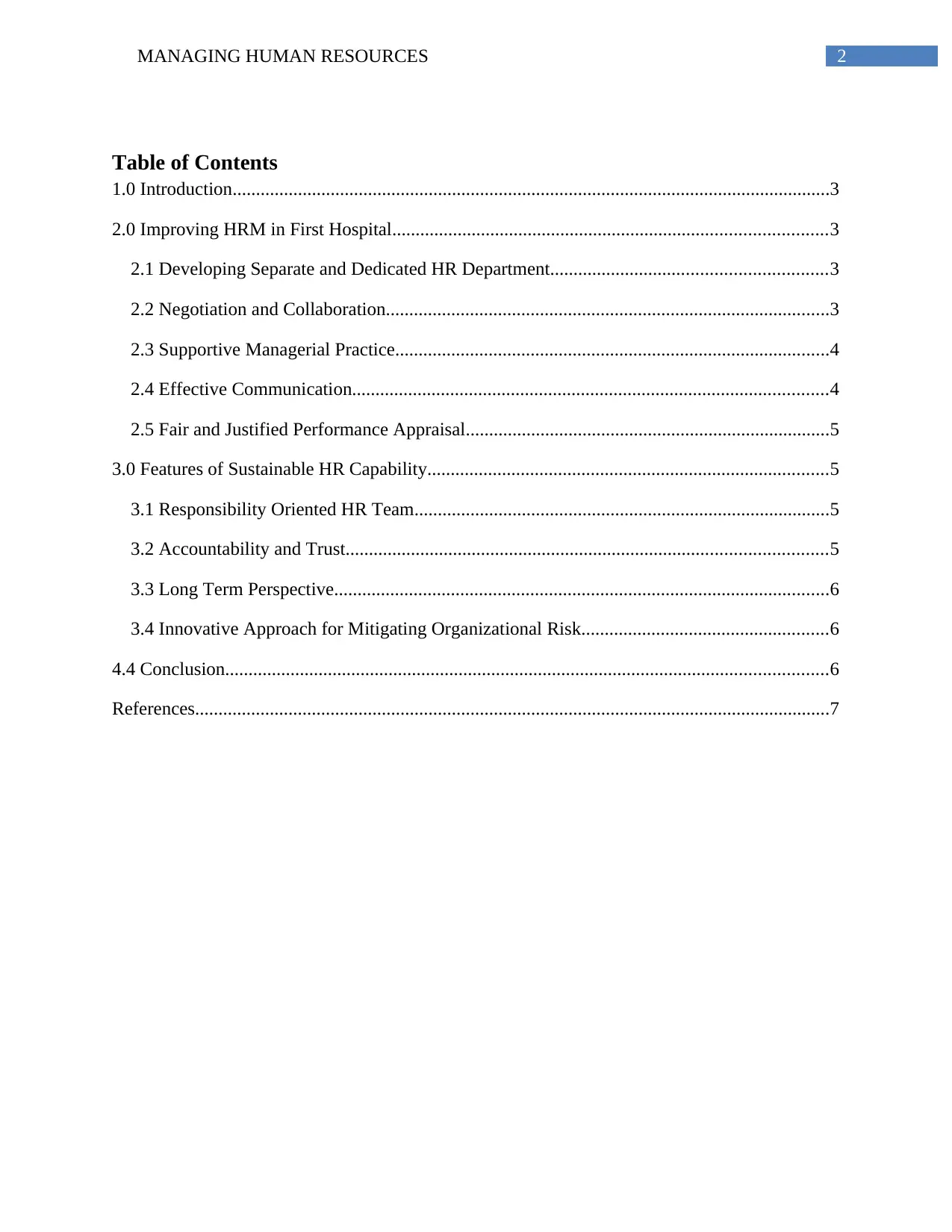
2MANAGING HUMAN RESOURCES
Table of Contents
1.0 Introduction................................................................................................................................3
2.0 Improving HRM in First Hospital.............................................................................................3
2.1 Developing Separate and Dedicated HR Department...........................................................3
2.2 Negotiation and Collaboration...............................................................................................3
2.3 Supportive Managerial Practice.............................................................................................4
2.4 Effective Communication......................................................................................................4
2.5 Fair and Justified Performance Appraisal..............................................................................5
3.0 Features of Sustainable HR Capability......................................................................................5
3.1 Responsibility Oriented HR Team.........................................................................................5
3.2 Accountability and Trust.......................................................................................................5
3.3 Long Term Perspective..........................................................................................................6
3.4 Innovative Approach for Mitigating Organizational Risk.....................................................6
4.4 Conclusion.................................................................................................................................6
References........................................................................................................................................7
Table of Contents
1.0 Introduction................................................................................................................................3
2.0 Improving HRM in First Hospital.............................................................................................3
2.1 Developing Separate and Dedicated HR Department...........................................................3
2.2 Negotiation and Collaboration...............................................................................................3
2.3 Supportive Managerial Practice.............................................................................................4
2.4 Effective Communication......................................................................................................4
2.5 Fair and Justified Performance Appraisal..............................................................................5
3.0 Features of Sustainable HR Capability......................................................................................5
3.1 Responsibility Oriented HR Team.........................................................................................5
3.2 Accountability and Trust.......................................................................................................5
3.3 Long Term Perspective..........................................................................................................6
3.4 Innovative Approach for Mitigating Organizational Risk.....................................................6
4.4 Conclusion.................................................................................................................................6
References........................................................................................................................................7
⊘ This is a preview!⊘
Do you want full access?
Subscribe today to unlock all pages.

Trusted by 1+ million students worldwide
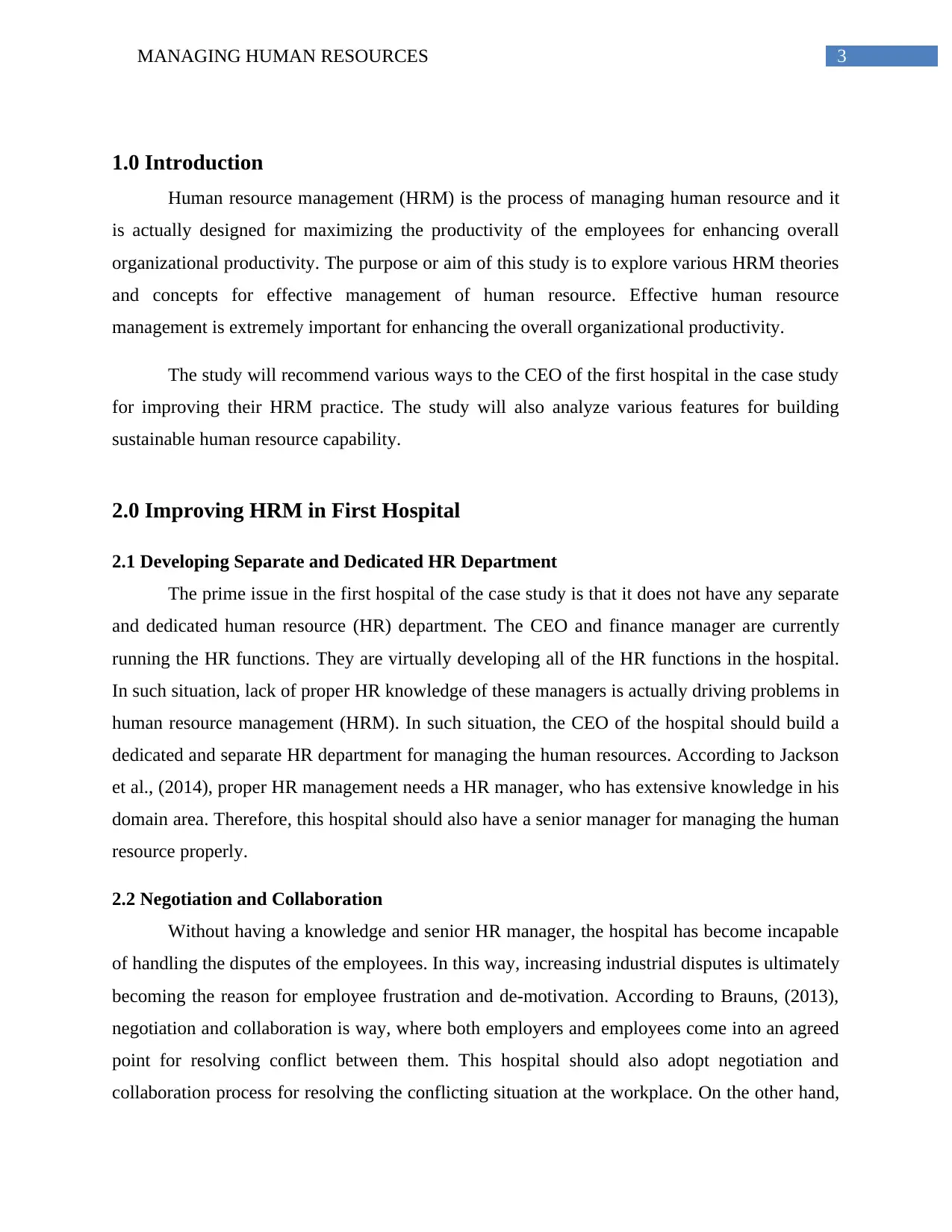
3MANAGING HUMAN RESOURCES
1.0 Introduction
Human resource management (HRM) is the process of managing human resource and it
is actually designed for maximizing the productivity of the employees for enhancing overall
organizational productivity. The purpose or aim of this study is to explore various HRM theories
and concepts for effective management of human resource. Effective human resource
management is extremely important for enhancing the overall organizational productivity.
The study will recommend various ways to the CEO of the first hospital in the case study
for improving their HRM practice. The study will also analyze various features for building
sustainable human resource capability.
2.0 Improving HRM in First Hospital
2.1 Developing Separate and Dedicated HR Department
The prime issue in the first hospital of the case study is that it does not have any separate
and dedicated human resource (HR) department. The CEO and finance manager are currently
running the HR functions. They are virtually developing all of the HR functions in the hospital.
In such situation, lack of proper HR knowledge of these managers is actually driving problems in
human resource management (HRM). In such situation, the CEO of the hospital should build a
dedicated and separate HR department for managing the human resources. According to Jackson
et al., (2014), proper HR management needs a HR manager, who has extensive knowledge in his
domain area. Therefore, this hospital should also have a senior manager for managing the human
resource properly.
2.2 Negotiation and Collaboration
Without having a knowledge and senior HR manager, the hospital has become incapable
of handling the disputes of the employees. In this way, increasing industrial disputes is ultimately
becoming the reason for employee frustration and de-motivation. According to Brauns, (2013),
negotiation and collaboration is way, where both employers and employees come into an agreed
point for resolving conflict between them. This hospital should also adopt negotiation and
collaboration process for resolving the conflicting situation at the workplace. On the other hand,
1.0 Introduction
Human resource management (HRM) is the process of managing human resource and it
is actually designed for maximizing the productivity of the employees for enhancing overall
organizational productivity. The purpose or aim of this study is to explore various HRM theories
and concepts for effective management of human resource. Effective human resource
management is extremely important for enhancing the overall organizational productivity.
The study will recommend various ways to the CEO of the first hospital in the case study
for improving their HRM practice. The study will also analyze various features for building
sustainable human resource capability.
2.0 Improving HRM in First Hospital
2.1 Developing Separate and Dedicated HR Department
The prime issue in the first hospital of the case study is that it does not have any separate
and dedicated human resource (HR) department. The CEO and finance manager are currently
running the HR functions. They are virtually developing all of the HR functions in the hospital.
In such situation, lack of proper HR knowledge of these managers is actually driving problems in
human resource management (HRM). In such situation, the CEO of the hospital should build a
dedicated and separate HR department for managing the human resources. According to Jackson
et al., (2014), proper HR management needs a HR manager, who has extensive knowledge in his
domain area. Therefore, this hospital should also have a senior manager for managing the human
resource properly.
2.2 Negotiation and Collaboration
Without having a knowledge and senior HR manager, the hospital has become incapable
of handling the disputes of the employees. In this way, increasing industrial disputes is ultimately
becoming the reason for employee frustration and de-motivation. According to Brauns, (2013),
negotiation and collaboration is way, where both employers and employees come into an agreed
point for resolving conflict between them. This hospital should also adopt negotiation and
collaboration process for resolving the conflicting situation at the workplace. On the other hand,
Paraphrase This Document
Need a fresh take? Get an instant paraphrase of this document with our AI Paraphraser
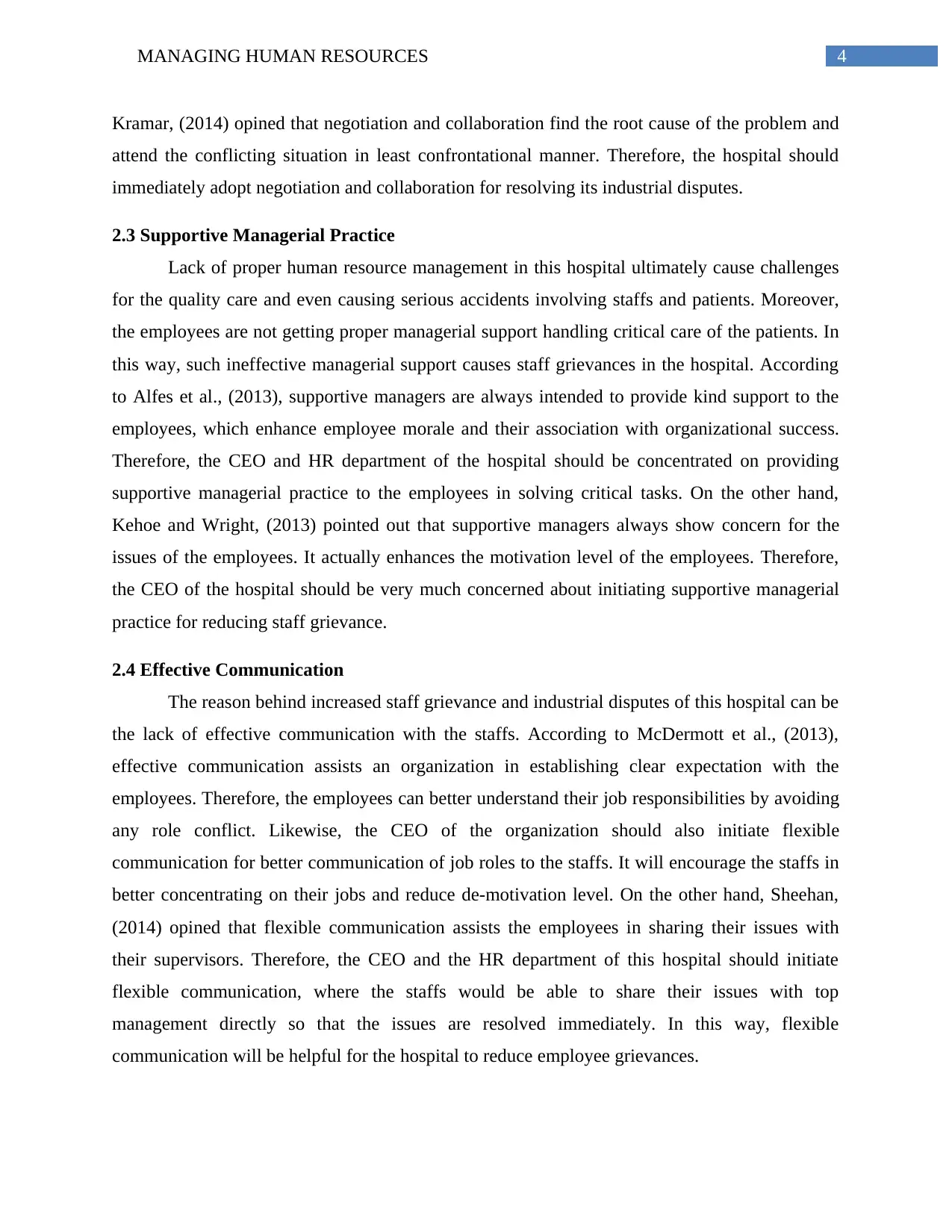
4MANAGING HUMAN RESOURCES
Kramar, (2014) opined that negotiation and collaboration find the root cause of the problem and
attend the conflicting situation in least confrontational manner. Therefore, the hospital should
immediately adopt negotiation and collaboration for resolving its industrial disputes.
2.3 Supportive Managerial Practice
Lack of proper human resource management in this hospital ultimately cause challenges
for the quality care and even causing serious accidents involving staffs and patients. Moreover,
the employees are not getting proper managerial support handling critical care of the patients. In
this way, such ineffective managerial support causes staff grievances in the hospital. According
to Alfes et al., (2013), supportive managers are always intended to provide kind support to the
employees, which enhance employee morale and their association with organizational success.
Therefore, the CEO and HR department of the hospital should be concentrated on providing
supportive managerial practice to the employees in solving critical tasks. On the other hand,
Kehoe and Wright, (2013) pointed out that supportive managers always show concern for the
issues of the employees. It actually enhances the motivation level of the employees. Therefore,
the CEO of the hospital should be very much concerned about initiating supportive managerial
practice for reducing staff grievance.
2.4 Effective Communication
The reason behind increased staff grievance and industrial disputes of this hospital can be
the lack of effective communication with the staffs. According to McDermott et al., (2013),
effective communication assists an organization in establishing clear expectation with the
employees. Therefore, the employees can better understand their job responsibilities by avoiding
any role conflict. Likewise, the CEO of the organization should also initiate flexible
communication for better communication of job roles to the staffs. It will encourage the staffs in
better concentrating on their jobs and reduce de-motivation level. On the other hand, Sheehan,
(2014) opined that flexible communication assists the employees in sharing their issues with
their supervisors. Therefore, the CEO and the HR department of this hospital should initiate
flexible communication, where the staffs would be able to share their issues with top
management directly so that the issues are resolved immediately. In this way, flexible
communication will be helpful for the hospital to reduce employee grievances.
Kramar, (2014) opined that negotiation and collaboration find the root cause of the problem and
attend the conflicting situation in least confrontational manner. Therefore, the hospital should
immediately adopt negotiation and collaboration for resolving its industrial disputes.
2.3 Supportive Managerial Practice
Lack of proper human resource management in this hospital ultimately cause challenges
for the quality care and even causing serious accidents involving staffs and patients. Moreover,
the employees are not getting proper managerial support handling critical care of the patients. In
this way, such ineffective managerial support causes staff grievances in the hospital. According
to Alfes et al., (2013), supportive managers are always intended to provide kind support to the
employees, which enhance employee morale and their association with organizational success.
Therefore, the CEO and HR department of the hospital should be concentrated on providing
supportive managerial practice to the employees in solving critical tasks. On the other hand,
Kehoe and Wright, (2013) pointed out that supportive managers always show concern for the
issues of the employees. It actually enhances the motivation level of the employees. Therefore,
the CEO of the hospital should be very much concerned about initiating supportive managerial
practice for reducing staff grievance.
2.4 Effective Communication
The reason behind increased staff grievance and industrial disputes of this hospital can be
the lack of effective communication with the staffs. According to McDermott et al., (2013),
effective communication assists an organization in establishing clear expectation with the
employees. Therefore, the employees can better understand their job responsibilities by avoiding
any role conflict. Likewise, the CEO of the organization should also initiate flexible
communication for better communication of job roles to the staffs. It will encourage the staffs in
better concentrating on their jobs and reduce de-motivation level. On the other hand, Sheehan,
(2014) opined that flexible communication assists the employees in sharing their issues with
their supervisors. Therefore, the CEO and the HR department of this hospital should initiate
flexible communication, where the staffs would be able to share their issues with top
management directly so that the issues are resolved immediately. In this way, flexible
communication will be helpful for the hospital to reduce employee grievances.
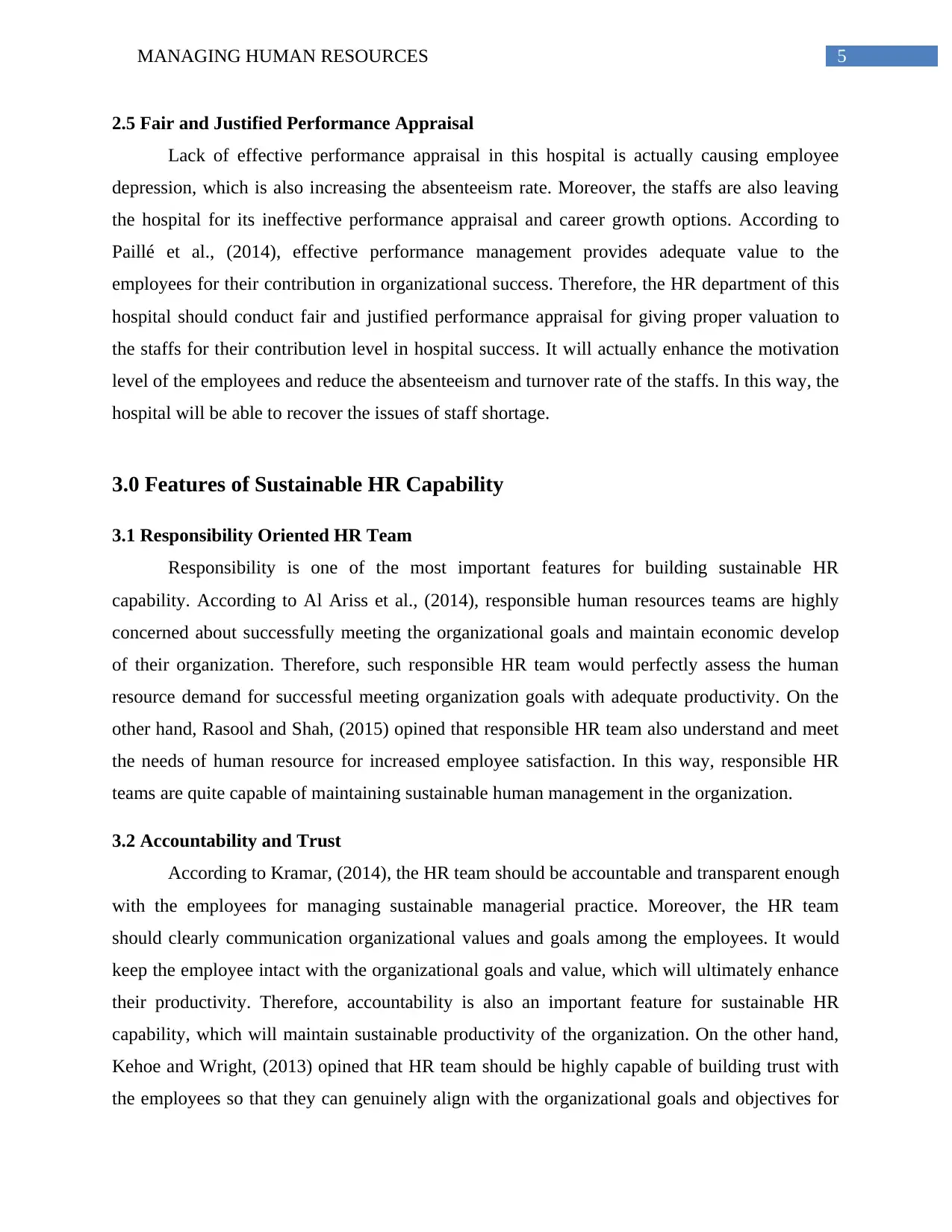
5MANAGING HUMAN RESOURCES
2.5 Fair and Justified Performance Appraisal
Lack of effective performance appraisal in this hospital is actually causing employee
depression, which is also increasing the absenteeism rate. Moreover, the staffs are also leaving
the hospital for its ineffective performance appraisal and career growth options. According to
Paillé et al., (2014), effective performance management provides adequate value to the
employees for their contribution in organizational success. Therefore, the HR department of this
hospital should conduct fair and justified performance appraisal for giving proper valuation to
the staffs for their contribution level in hospital success. It will actually enhance the motivation
level of the employees and reduce the absenteeism and turnover rate of the staffs. In this way, the
hospital will be able to recover the issues of staff shortage.
3.0 Features of Sustainable HR Capability
3.1 Responsibility Oriented HR Team
Responsibility is one of the most important features for building sustainable HR
capability. According to Al Ariss et al., (2014), responsible human resources teams are highly
concerned about successfully meeting the organizational goals and maintain economic develop
of their organization. Therefore, such responsible HR team would perfectly assess the human
resource demand for successful meeting organization goals with adequate productivity. On the
other hand, Rasool and Shah, (2015) opined that responsible HR team also understand and meet
the needs of human resource for increased employee satisfaction. In this way, responsible HR
teams are quite capable of maintaining sustainable human management in the organization.
3.2 Accountability and Trust
According to Kramar, (2014), the HR team should be accountable and transparent enough
with the employees for managing sustainable managerial practice. Moreover, the HR team
should clearly communication organizational values and goals among the employees. It would
keep the employee intact with the organizational goals and value, which will ultimately enhance
their productivity. Therefore, accountability is also an important feature for sustainable HR
capability, which will maintain sustainable productivity of the organization. On the other hand,
Kehoe and Wright, (2013) opined that HR team should be highly capable of building trust with
the employees so that they can genuinely align with the organizational goals and objectives for
2.5 Fair and Justified Performance Appraisal
Lack of effective performance appraisal in this hospital is actually causing employee
depression, which is also increasing the absenteeism rate. Moreover, the staffs are also leaving
the hospital for its ineffective performance appraisal and career growth options. According to
Paillé et al., (2014), effective performance management provides adequate value to the
employees for their contribution in organizational success. Therefore, the HR department of this
hospital should conduct fair and justified performance appraisal for giving proper valuation to
the staffs for their contribution level in hospital success. It will actually enhance the motivation
level of the employees and reduce the absenteeism and turnover rate of the staffs. In this way, the
hospital will be able to recover the issues of staff shortage.
3.0 Features of Sustainable HR Capability
3.1 Responsibility Oriented HR Team
Responsibility is one of the most important features for building sustainable HR
capability. According to Al Ariss et al., (2014), responsible human resources teams are highly
concerned about successfully meeting the organizational goals and maintain economic develop
of their organization. Therefore, such responsible HR team would perfectly assess the human
resource demand for successful meeting organization goals with adequate productivity. On the
other hand, Rasool and Shah, (2015) opined that responsible HR team also understand and meet
the needs of human resource for increased employee satisfaction. In this way, responsible HR
teams are quite capable of maintaining sustainable human management in the organization.
3.2 Accountability and Trust
According to Kramar, (2014), the HR team should be accountable and transparent enough
with the employees for managing sustainable managerial practice. Moreover, the HR team
should clearly communication organizational values and goals among the employees. It would
keep the employee intact with the organizational goals and value, which will ultimately enhance
their productivity. Therefore, accountability is also an important feature for sustainable HR
capability, which will maintain sustainable productivity of the organization. On the other hand,
Kehoe and Wright, (2013) opined that HR team should be highly capable of building trust with
the employees so that they can genuinely align with the organizational goals and objectives for
⊘ This is a preview!⊘
Do you want full access?
Subscribe today to unlock all pages.

Trusted by 1+ million students worldwide
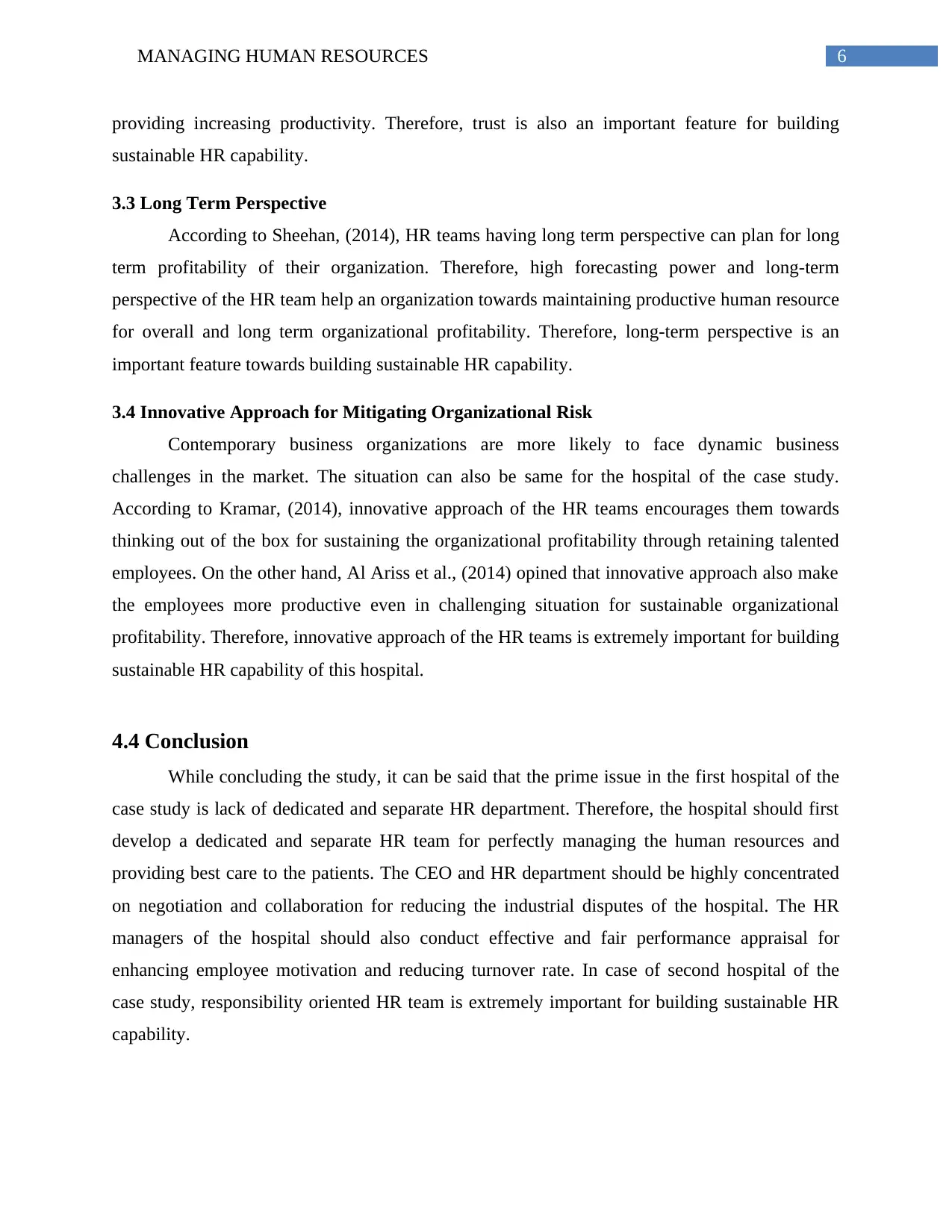
6MANAGING HUMAN RESOURCES
providing increasing productivity. Therefore, trust is also an important feature for building
sustainable HR capability.
3.3 Long Term Perspective
According to Sheehan, (2014), HR teams having long term perspective can plan for long
term profitability of their organization. Therefore, high forecasting power and long-term
perspective of the HR team help an organization towards maintaining productive human resource
for overall and long term organizational profitability. Therefore, long-term perspective is an
important feature towards building sustainable HR capability.
3.4 Innovative Approach for Mitigating Organizational Risk
Contemporary business organizations are more likely to face dynamic business
challenges in the market. The situation can also be same for the hospital of the case study.
According to Kramar, (2014), innovative approach of the HR teams encourages them towards
thinking out of the box for sustaining the organizational profitability through retaining talented
employees. On the other hand, Al Ariss et al., (2014) opined that innovative approach also make
the employees more productive even in challenging situation for sustainable organizational
profitability. Therefore, innovative approach of the HR teams is extremely important for building
sustainable HR capability of this hospital.
4.4 Conclusion
While concluding the study, it can be said that the prime issue in the first hospital of the
case study is lack of dedicated and separate HR department. Therefore, the hospital should first
develop a dedicated and separate HR team for perfectly managing the human resources and
providing best care to the patients. The CEO and HR department should be highly concentrated
on negotiation and collaboration for reducing the industrial disputes of the hospital. The HR
managers of the hospital should also conduct effective and fair performance appraisal for
enhancing employee motivation and reducing turnover rate. In case of second hospital of the
case study, responsibility oriented HR team is extremely important for building sustainable HR
capability.
providing increasing productivity. Therefore, trust is also an important feature for building
sustainable HR capability.
3.3 Long Term Perspective
According to Sheehan, (2014), HR teams having long term perspective can plan for long
term profitability of their organization. Therefore, high forecasting power and long-term
perspective of the HR team help an organization towards maintaining productive human resource
for overall and long term organizational profitability. Therefore, long-term perspective is an
important feature towards building sustainable HR capability.
3.4 Innovative Approach for Mitigating Organizational Risk
Contemporary business organizations are more likely to face dynamic business
challenges in the market. The situation can also be same for the hospital of the case study.
According to Kramar, (2014), innovative approach of the HR teams encourages them towards
thinking out of the box for sustaining the organizational profitability through retaining talented
employees. On the other hand, Al Ariss et al., (2014) opined that innovative approach also make
the employees more productive even in challenging situation for sustainable organizational
profitability. Therefore, innovative approach of the HR teams is extremely important for building
sustainable HR capability of this hospital.
4.4 Conclusion
While concluding the study, it can be said that the prime issue in the first hospital of the
case study is lack of dedicated and separate HR department. Therefore, the hospital should first
develop a dedicated and separate HR team for perfectly managing the human resources and
providing best care to the patients. The CEO and HR department should be highly concentrated
on negotiation and collaboration for reducing the industrial disputes of the hospital. The HR
managers of the hospital should also conduct effective and fair performance appraisal for
enhancing employee motivation and reducing turnover rate. In case of second hospital of the
case study, responsibility oriented HR team is extremely important for building sustainable HR
capability.
Paraphrase This Document
Need a fresh take? Get an instant paraphrase of this document with our AI Paraphraser
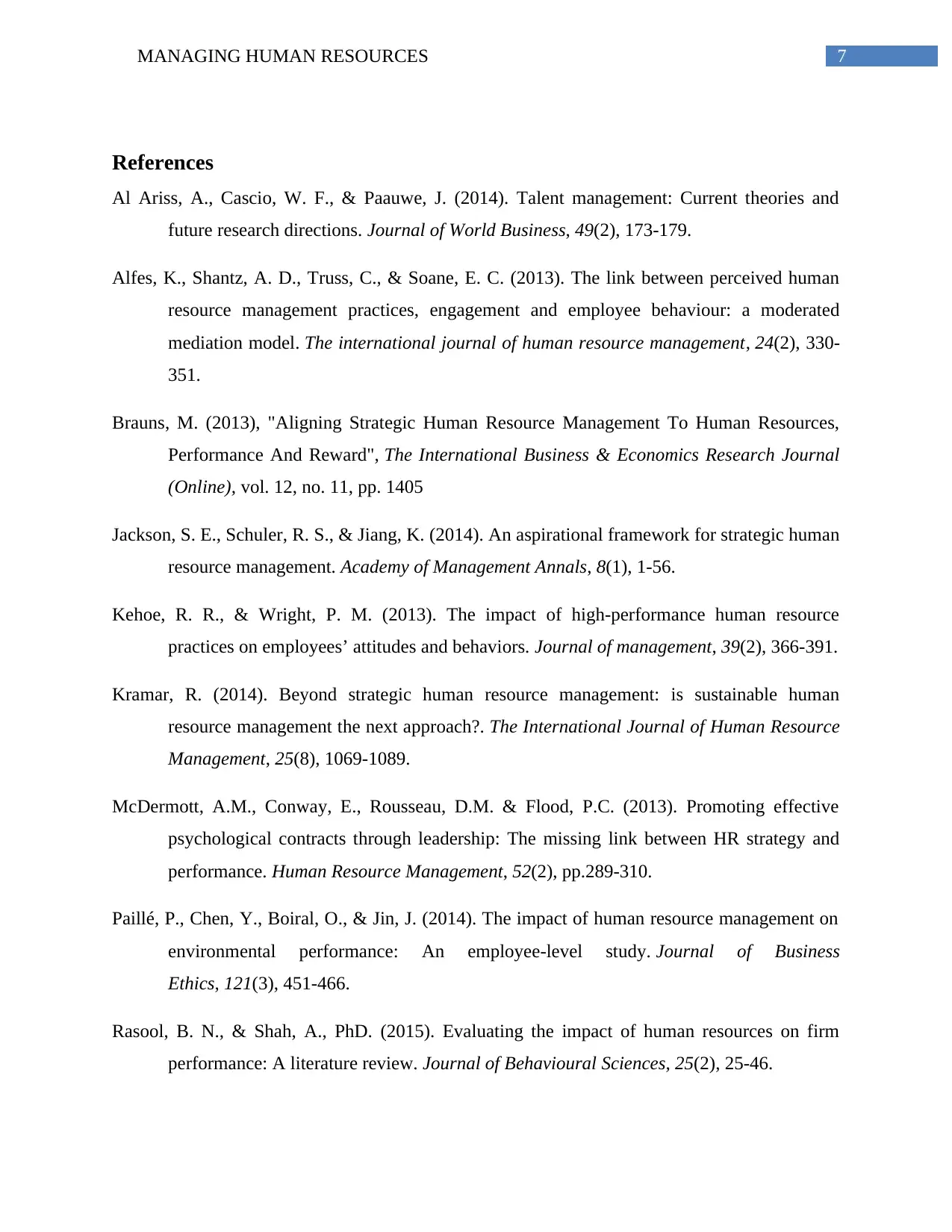
7MANAGING HUMAN RESOURCES
References
Al Ariss, A., Cascio, W. F., & Paauwe, J. (2014). Talent management: Current theories and
future research directions. Journal of World Business, 49(2), 173-179.
Alfes, K., Shantz, A. D., Truss, C., & Soane, E. C. (2013). The link between perceived human
resource management practices, engagement and employee behaviour: a moderated
mediation model. The international journal of human resource management, 24(2), 330-
351.
Brauns, M. (2013), "Aligning Strategic Human Resource Management To Human Resources,
Performance And Reward", The International Business & Economics Research Journal
(Online), vol. 12, no. 11, pp. 1405
Jackson, S. E., Schuler, R. S., & Jiang, K. (2014). An aspirational framework for strategic human
resource management. Academy of Management Annals, 8(1), 1-56.
Kehoe, R. R., & Wright, P. M. (2013). The impact of high-performance human resource
practices on employees’ attitudes and behaviors. Journal of management, 39(2), 366-391.
Kramar, R. (2014). Beyond strategic human resource management: is sustainable human
resource management the next approach?. The International Journal of Human Resource
Management, 25(8), 1069-1089.
McDermott, A.M., Conway, E., Rousseau, D.M. & Flood, P.C. (2013). Promoting effective
psychological contracts through leadership: The missing link between HR strategy and
performance. Human Resource Management, 52(2), pp.289-310.
Paillé, P., Chen, Y., Boiral, O., & Jin, J. (2014). The impact of human resource management on
environmental performance: An employee-level study. Journal of Business
Ethics, 121(3), 451-466.
Rasool, B. N., & Shah, A., PhD. (2015). Evaluating the impact of human resources on firm
performance: A literature review. Journal of Behavioural Sciences, 25(2), 25-46.
References
Al Ariss, A., Cascio, W. F., & Paauwe, J. (2014). Talent management: Current theories and
future research directions. Journal of World Business, 49(2), 173-179.
Alfes, K., Shantz, A. D., Truss, C., & Soane, E. C. (2013). The link between perceived human
resource management practices, engagement and employee behaviour: a moderated
mediation model. The international journal of human resource management, 24(2), 330-
351.
Brauns, M. (2013), "Aligning Strategic Human Resource Management To Human Resources,
Performance And Reward", The International Business & Economics Research Journal
(Online), vol. 12, no. 11, pp. 1405
Jackson, S. E., Schuler, R. S., & Jiang, K. (2014). An aspirational framework for strategic human
resource management. Academy of Management Annals, 8(1), 1-56.
Kehoe, R. R., & Wright, P. M. (2013). The impact of high-performance human resource
practices on employees’ attitudes and behaviors. Journal of management, 39(2), 366-391.
Kramar, R. (2014). Beyond strategic human resource management: is sustainable human
resource management the next approach?. The International Journal of Human Resource
Management, 25(8), 1069-1089.
McDermott, A.M., Conway, E., Rousseau, D.M. & Flood, P.C. (2013). Promoting effective
psychological contracts through leadership: The missing link between HR strategy and
performance. Human Resource Management, 52(2), pp.289-310.
Paillé, P., Chen, Y., Boiral, O., & Jin, J. (2014). The impact of human resource management on
environmental performance: An employee-level study. Journal of Business
Ethics, 121(3), 451-466.
Rasool, B. N., & Shah, A., PhD. (2015). Evaluating the impact of human resources on firm
performance: A literature review. Journal of Behavioural Sciences, 25(2), 25-46.
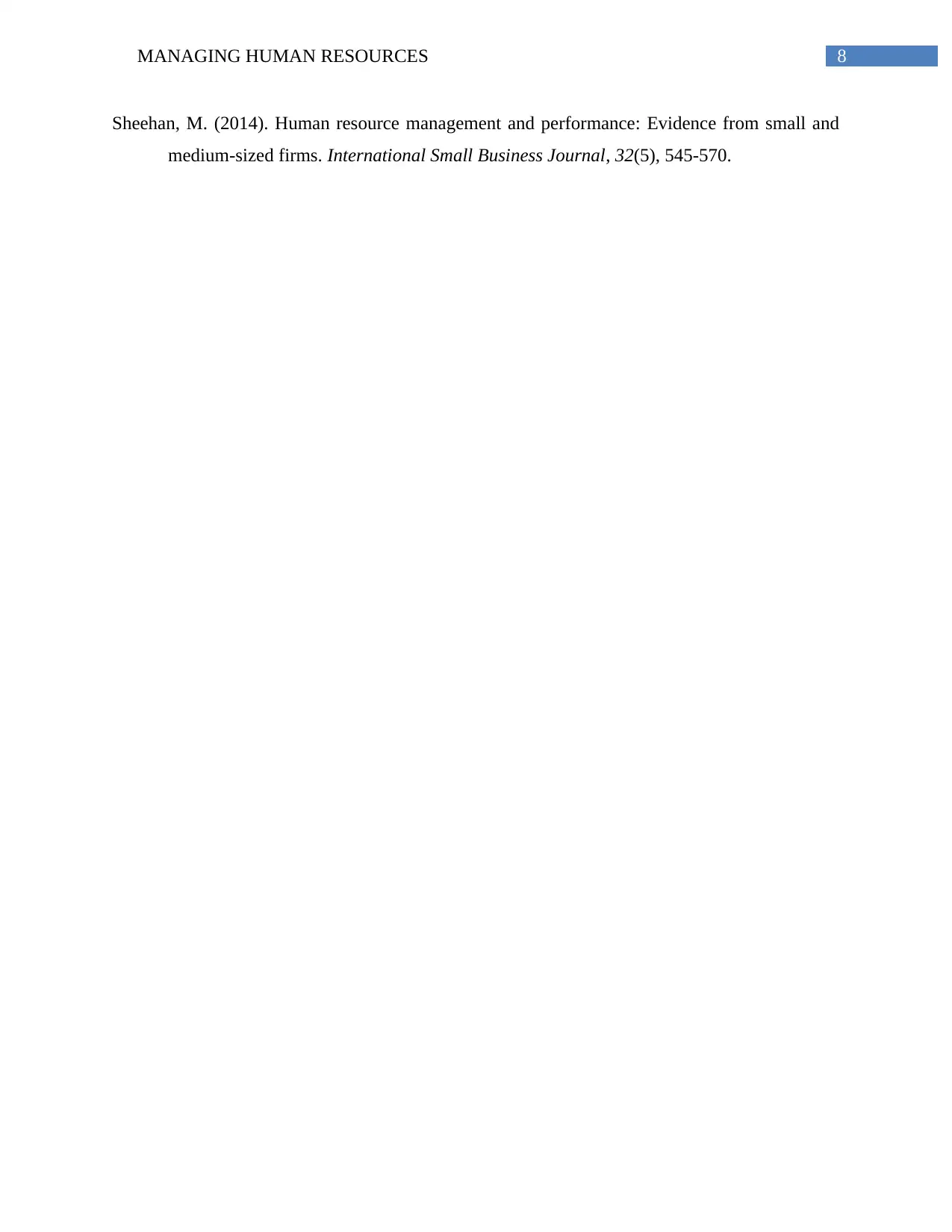
8MANAGING HUMAN RESOURCES
Sheehan, M. (2014). Human resource management and performance: Evidence from small and
medium-sized firms. International Small Business Journal, 32(5), 545-570.
Sheehan, M. (2014). Human resource management and performance: Evidence from small and
medium-sized firms. International Small Business Journal, 32(5), 545-570.
⊘ This is a preview!⊘
Do you want full access?
Subscribe today to unlock all pages.

Trusted by 1+ million students worldwide
1 out of 9
Related Documents
Your All-in-One AI-Powered Toolkit for Academic Success.
+13062052269
info@desklib.com
Available 24*7 on WhatsApp / Email
![[object Object]](/_next/static/media/star-bottom.7253800d.svg)
Unlock your academic potential
Copyright © 2020–2025 A2Z Services. All Rights Reserved. Developed and managed by ZUCOL.





